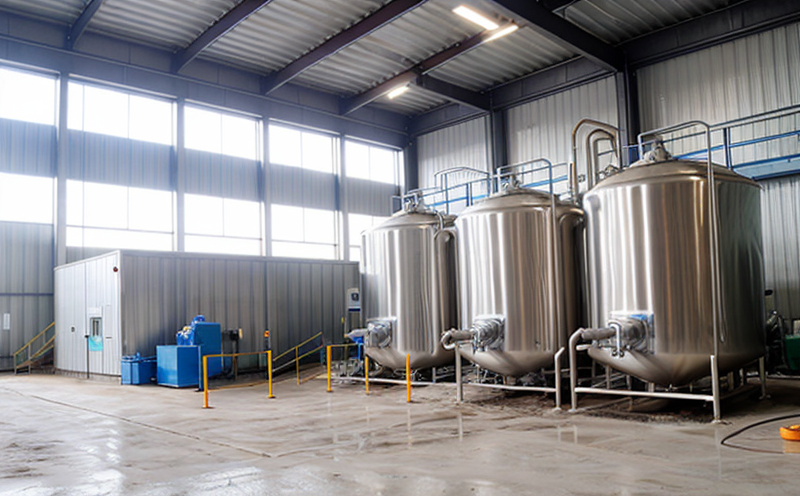ISO 9377-2 Hydrocarbon Oil Index Test in Process Water
The ISO 9377-2 standard provides a method to determine the hydrocarbon oil index (HOI) in process water. This test is crucial for industries where contamination by hydrocarbons could lead to environmental, operational, or safety issues. The HOI test helps in monitoring and controlling the level of petroleum-derived compounds in industrial process waters, ensuring compliance with regulatory standards and maintaining the quality and integrity of production processes.
The test involves several steps, including sample collection, preparation, and analysis using a spectrophotometer to measure absorbance at specific wavelengths. The HOI is calculated based on these measurements according to the formula provided in ISO 9377-2. This method ensures accurate quantification of hydrocarbon oils present in process water samples.
Understanding the significance of this test requires recognizing its role in various industrial processes, such as those involving petrochemicals, refineries, and chemical manufacturing plants. In these environments, even trace amounts of hydrocarbons can have significant impacts on equipment performance, product quality, and environmental health. By implementing ISO 9377-2 testing regularly, industries can proactively manage risks associated with hydrocarbon contamination.
Regular monitoring through HOI testing supports compliance with environmental regulations like the European Union's REACH directive or the U.S. Environmental Protection Agency's (EPA) guidelines. It also aids in maintaining internal quality control standards that are essential for sustainable operations and customer satisfaction.
The reliability of ISO 9377-2 test results depends on proper sample handling, accurate instrumentation, and adherence to specified procedures. At Eurolab, our experienced scientists ensure each step is performed rigorously according to international standards, providing clients with precise HOI measurements they can trust.
Why It Matters
The importance of the ISO 9377-2 test cannot be overstated for industries reliant on clean process water. Contaminants from hydrocarbons not only affect product quality but also pose serious risks to both human health and ecosystems. For instance, in petrochemical plants, any trace amounts of hydrocarbon oil could lead to fouling or degradation of critical machinery, resulting in costly downtime and maintenance.
Moreover, environmental considerations play a vital role in industrial processes. The presence of hydrocarbons can disrupt natural habitats and harm aquatic life if released into water bodies via effluent streams. By adhering to ISO 9377-2 standards, industries contribute positively to environmental conservation efforts by minimizing such risks.
From an operational standpoint, maintaining low HOI levels in process waters reduces maintenance costs while enhancing overall efficiency. Cleaner water leads to better performance of downstream processes and helps meet stringent quality targets set by customers or regulatory bodies.
In summary, the ISO 9377-2 test serves as a cornerstone for ensuring safe, efficient, and environmentally responsible industrial operations involving process water.
Scope and Methodology
The scope of the ISO 9377-2 hydrocarbon oil index test encompasses the determination of petroleum-derived compounds in various types of process waters used across different industries. This includes but is not limited to cooling towers, boiler feed systems, condensers, and other equipment that handle large volumes of water during manufacturing processes.
The methodology outlined in ISO 9377-2 specifies several key steps for conducting the test:
- Sample Collection: Properly collect representative samples from points where process waters are in contact with hydrocarbons.
- Preparation: Dilute or concentrate the sample as necessary to fall within the linear range of the spectrophotometer used for analysis.
- Analysis: Measure absorbance at 280 nm and 650 nm using a UV-Vis spectrophotometer. Calculate HOI based on these values using the formula provided in ISO 9377-2.
The accuracy of the test results hinges upon meticulous sample preparation and adherence to standardized procedures throughout the process. Eurolab employs advanced instrumentation and trained technicians to guarantee precision and consistency.
Eurolab Advantages
At Eurolab, we pride ourselves on delivering exceptional service in ISO 9377-2 hydrocarbon oil index testing for process water. Our advantages include:
- Experienced Professionals: Our team consists of experts certified to perform this specific test according to international standards.
- State-of-the-Art Equipment: We utilize high-precision spectrophotometers and other cutting-edge instruments to ensure reliable data collection.
- Comprehensive Reporting: In addition to numerical results, our reports provide detailed insights into potential areas of concern and recommendations for corrective actions.
- Quick Turnaround Times: We prioritize customer satisfaction by delivering timely test results within agreed-upon deadlines.
- Customer Support: Our dedicated support team is always available to answer questions and address any concerns related to testing or interpretation of results.
These factors combined make Eurolab the premier choice for accurate, reliable ISO 9377-2 hydrocarbon oil index testing in process water.





